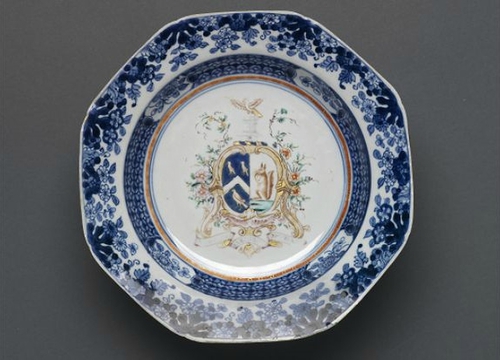New display includes many hidden treasures of the Royal Ontario Museum's Far Eastern collections
Album of pith paper paintings showing insects and plants (purple hibiscus, butterfly and katydid), 19th century. ROM East Asian Collection 990.100.1. Gift of Professor Peter Brock.
TORONTO.- The Herman Herzog Levy Gallery at the Royal Ontario Museum plays host to Made in China: Cultural Encounters Through Export Art from September 5, 2015 to August 2016.
Oil portrait of a Chinese lady, 19th century. 920.21.57.1 The George Crofts Collection, ROM East Asian Collection.
Primarily originating from four renowned ROM collections, Made in China features nearly 100 objects including paintings, porcelain, lacquer, silver, and photography. Displayed over several rotations, these pieces were created in the 18th and 19th centuries for enthusiastic European and North American consumers. Placing the “Made in China” trademark in historical context, the exhibition explores the cultural encounters between China and the west, revealing a dynamic history of export trade centered in the port city of Canton (known today as Guangzhou).
Leaf. Gift of Richard W. Schroder in memory of his grandfather Wilson Gibbs McKay.
Dr. Jianfei He, the ROM’s James M. Menzies Chinese Research Fellow, is the exhibition guest curator. Dr. Wen-chien Cheng, the ROM’s Louise Hawley Stone Chair of Far Eastern Art, is curatorial supervisor. Both are associated with the Museum’s World Cultures department.
Wallpaper, Qing dynasty, 19th century. Ink and colour on paper. Gift of Mr. Noah Torno.
Chinese export art is associated with both Chinese art traditions and Western ideas, revealing how its development and production were affected by the trade routes and cultural exhanges continuing today. Like many products manufactured in China today, the works created centuries ago served as decorative art and souvenirs for foreigners. Examples of pith paper paintings, a materially demanding and technically complex art form, are among the highlights of this intimate exhibition. Derived from the ginseng family, pith paper is strong and, when damp, may be stretched and folded into nearly any shape. Watercolours and tempera are absorbed easily, creating a relief texture with a velvety visual depth. Rarely publicly displayed, these paintings are among the hidden treasures of the ROM’s Far Eastern holdings. Beyond this distinction, these works embody the exhibition’s theme: a lens through which extraordinary cultural encounters are witnessed. As the West had an appetite for Chinese art, Chinese artists responded enthusiastically to western tastes. Scenes painted on the pith paper romanticized Chinese customs, daily life, landscapes, and exotic plants and insects—all serving to evoke fantasized images of China for Westerners.
White soup plate with blue and white border. ROM European Collection.
Establishing that this tradition continues to this day is the inclusion of a set of contemprary hand-painted wallpaper commissioned especially for the ROM’s exhibition and created by a modern workshop in Shenzhen, China. A diverse group of specimens and objects from a number of different collections— from insects of the ROM’s entromology department corresponding to those seen in nearby pith paper paintings to a silver goblet from the Museum’s European deocorative arts department depicting a dramatic scene—round out the display.
Pith paper painting showing a European prisoner in cage. ROM East Asian Collection.

/https%3A%2F%2Fprofilepics.canalblog.com%2Fprofilepics%2F1%2F0%2F100183.jpg)
/https%3A%2F%2Fstorage.canalblog.com%2F03%2F02%2F119589%2F96711876_o.jpg)
/https%3A%2F%2Fstorage.canalblog.com%2F11%2F31%2F119589%2F94773502_o.jpg)
/https%3A%2F%2Fstorage.canalblog.com%2F20%2F83%2F119589%2F94772815_o.jpg)
/https%3A%2F%2Fstorage.canalblog.com%2F26%2F72%2F119589%2F75604929_o.jpg)
/https%3A%2F%2Fstorage.canalblog.com%2F59%2F60%2F119589%2F26458628_o.jpg)








/http%3A%2F%2Fstorage.canalblog.com%2F00%2F00%2F119589%2F129758935_o.jpg)
/http%3A%2F%2Fstorage.canalblog.com%2F29%2F28%2F119589%2F129637299_o.jpg)
/http%3A%2F%2Fstorage.canalblog.com%2F88%2F37%2F119589%2F129631480_o.jpg)
/http%3A%2F%2Fstorage.canalblog.com%2F77%2F79%2F119589%2F129631259_o.jpg)